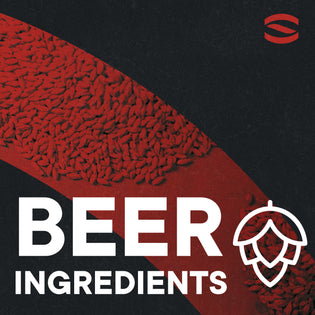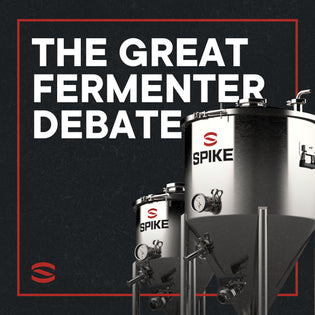Welcome to the world of craft beer! Craft beer, is a beverage made with passion and skill by small, independent brewers. It's becoming increasingly popular as more and more people are discovering the unique flavors and aromas of these craft brews.

In this article, we'll explore the basics of the brewing process of craft beer, the different types of hops, grains, and yeasts, and the various methods used to add flavor to beer. We will also discuss water chemistry, pH balance, and the shelf life of craft beer.
Finally, we will answer some frequently asked questions to help you get started on your brewing journey.
What Is Craft Beer?
Craft beer is a beer usually brewed by independent breweries with traditional ingredients, such as malted barley, hops, water, and yeast, and is usually brewed in a small quantity. As a craft beer, it is often made with much more attention to detail than mass-produced beer, resulting in a unique flavor and a higher quality product.

How Is Craft Beer Made? The Brewing Process
The brewing process of craft beer involves several steps. Let’s take them one after the other.
Milling
Milling is the first step in the brewing process of beer. It involves crushing grains such as malted barley, wheat, rye, oats, or corn into smaller pieces to be used in brewing.
Mashing
Mashing helps to extract the sugars from the grains that will eventually turn into alcohol. In mashing, the grains are steeped in hot water for an extended period of time, usually between 45 and 90 minutes. During this time, the enzymes in the grains break down the starches into simple sugars, which can then be fermented.
Once the mashing is finished, the liquid, known as "wort," is separated from the grains. The wort is then boiled, and hops are added to it before fermentation.
Lautering
Lautering is the process of separating the liquid wort from the spent grains. The lautering process begins by recirculating the wort through the lauter tun, a large vessel with small holes which allows the liquid wort to pass through while the spent grains remain.
Lautering helps to clarify the wort and remove any unwanted proteins and other particles that can affect the flavor and clarity of the beer.
Boiling
During boiling, the wort is heated to a temperature of about 100°C (212°F) to sterilize the wort and extract bitterness and other flavors from the hops. The boil time can vary from 30 minutes to two hours, depending on the recipe.
Adding Hops
Hops are a flower added to the boiling wort to impart bitterness, flavor, and aroma. The hop additions also act as a preservative, helping to extend the shelf life of the beer.
When adding hops, the brewer needs to consider the type of beer they are making. Different hop varieties will impart different flavors, aromas, and bitterness levels. With the right combination of hops, the brewer can create a beer that is full of flavor and aroma.
Whirlpool And Cooling
Whirlpooling is a great way to improve the clarity and flavor of the beer. The process is used to separate the solids from the liquid, and it also helps to reduce the number of unwanted proteins and polyphenols in the beer.
Fermentation
Fermentation is the process of converting sugar into alcohol and carbon dioxide. It is the most important part of the brewing process and is the key to creating a delicious craft beer. During fermentation, yeast consumes the sugar in the wort, produces alcohol, and creates beer.
Conditioning
Conditioning is an important step in brewing, as it allows the beer to reach its desired flavor profile. It also helps the beer to clarify and carbonate, giving it the perfect level of carbonation and clarity. The beer would not have the same flavor, clarity, or carbonation without conditioning.
Filtration
Filtration is an essential step in the brewing process that helps to ensure that the finished beer is of the highest quality and tastes great when it is ready to be consumed. It helps to clarify the beer, remove solids, and improve its shelf life.
It also helps to extract diacetyl and oxygen, which can cause the beer to go stale. By understanding the filtration process, brewers can ensure that their beer is of the highest quality.
Packaging And Carbonation
Once the beer is packaged and carbonated, it is ready to be enjoyed. Packaging and carbonation are the final steps in the brewing process, and they play a significant role in the quality and shelf life of the beer. With the right techniques and ingredients, you can create a delicious craft beer that will be enjoyed by all.

What Are The Basic Ingredients of Craft Beer?
Craft beer is made up of four basic ingredients: water, hops, malted grains, and yeast. Each of these ingredients has a unique role to play in the brewing process and can be used to create a wide range of flavors and styles.

Water: What You Should Consider
When selecting water for brewing, it’s important to consider the mineral content, pH level, chlorine content, and mineral content of the water. Considering these factors can help ensure you get the best possible beer.
Water Chemistry
Water Chemistry is an important factor in brewing beer. It affects the taste, color, and texture of the beer. To create the perfect brew, it is crucial to understand the chemistry of the water you are using. By doing this, you can better control the flavor of your beer. This will help you create the perfect brew for your palate.
Ph Balance
The pH balance measures how acidic or alkaline a beer is. As a general rule, the lower the pH, the more acidic the beer is, and the higher the pH, the more alkaline the beer is.
It is important to understand how the pH affects the flavor and aroma of the beer and to adjust the pH accordingly. With the right balance, you can create a beer that is full of flavor and complexity.
Popular Types Of Hops
Hops are an essential ingredient in beer, providing bitterness, flavor, and aroma. Popular types of hops used in craft beer include Citra, Mosaic, Cascade, Magnum, Simcoe, Saaz, Amarillo, and Centennial. Each of these hops has its own unique characteristics, adding flavor and aroma to the beer.
Citra
Citra hops are known for their intense aroma and flavor notes of tropical fruit, citrus, and melon when brewing craft beer. They are typically used as a finishing hop and have a moderate alpha acid content (11-14%) and low cohumulone content, making them a balanced hop option.
They are commonly used in IPAs, pale ales, wheat beers, ciders, and meads. The addition of Citra hops to your beer can add a unique depth of flavor and aroma.
Mosaic
Mosaic hops are a relatively new variety, but it is a great choice for craft brewers. These hops have a unique flavor profile, with a distinct fruity aroma and flavor that can range from citrusy and tropical to earthy and piney.
Cascade
Cascade hops are known for their floral and citrus aromas, with notes of grapefruit and tangerine. The flavor of Cascade hops is often described as having a pleasant hoppy bitterness with a hint of fruitiness. When used in the brewing process, Cascade hops can provide a nice balance of bitterness and flavor to the beer.
Magnum
Magnum hops have a spicy, herbal aroma and a slightly citrusy flavor. It is often used in IPAs, pale ales, and stouts. Magnum hops are also used to balance out the sweetness of malts, adding a more complex flavor. When used in combination with other hops, it can add a unique flavor to the beer.
Simcoe
Simcoe hops are a great choice for any beer enthusiast looking to add a unique flavor and aroma to their beer. With their high alpha acid content, intense flavor and aroma, and versatile nature, Simcoe hops are sure to add something special to your beer.
Saaz
Saaz hops are a classic, noble hop variety originating in the Czech Republic. They have a mild, herbal aroma and flavor, with hints of lemon and lime. They are a popular choice for traditional German-style lagers, pilsners, and Belgian wheat beers.
Amarillo
When using Amarillo hops in your beer, it is important to remember that they have a high alpha acid content, so you should use them sparingly in order to avoid an overly bitter beer.
It is also important to remember that Amarillo hops are best used in combination with other hops, as their intense flavor can overpower the other flavors in the beer.
Centennial
Centennial hops are an excellent choice for brewers looking to add a strong hop presence to their beer. The moderate alpha acid content and bitterness rating make them a great choice for a wide variety of beer styles.
The citrusy and floral notes of Centennial hops can add complexity and depth to various beer styles, making them a remarkable choice for brewers looking to add a strong hop presence to their beer.
What Grains Can You Use?
When it comes to brewing beer, the type of grain you use can make a big difference in the flavor and texture of the final product. Malted barley is the most commonly used grain in beer, but other grains such as wheat, rye, oats, corn, and rice can also be used.
Malted Barley
Malted barley is usually the base malt used in beer, providing the majority of the fermentable sugars. It is also the main source of flavor and aroma, as the malting process brings out the unique characteristics of the grain. Different types of barley can be used to create different flavors, from light and malty to dark and roasted.

Wheat
Wheat is one of the most popular grains used in the production of craft beer. Wheat beer has a unique flavor with a light and refreshing taste. The grain is full of proteins, vitamins, and minerals, making it a fantastic option for a healthy beer. Wheat also gives the beer a creamy texture and a slightly sweet flavor.
Rye And Oats
Rye and oats are two grains that can be used to make craft beer. Rye is a cereal grain with a distinct spicy and earthy flavor, while oats have a sweet and nutty flavor. Rye and oats can be used to make a variety of beer styles, from light lagers to dark stouts.
Corn
Corn can be a great addition to any beer and can add a unique flavor and texture to your brew. It is important to ensure that you properly prepare the grain and mash it to the correct temperature and time to get the most out of it. With the right preparation, you can create a unique and delicious beer with the addition of corn.
Rice
Rice is a grain that is often the main ingredient in the brewing of beer. It is a relatively neutral grain that can be used to lighten the body and color of a beer, making it more crisp and refreshing. It can also be used to add a subtle sweetness to the beer.
Different Yeasts And How They Change Your Beer
Yeast is essential for the fermentation of sugars into alcohol, allowing for different types of beer. They include:
Ale Yeast
Ale yeast is a popular yeast strain used in craft beer brewing due to its ability to produce a variety of flavors, aromas, and colors. Brewers should consider the desired flavor profile, fermentation temperature, and potential off-flavors to create a unique and flavorful beer when selecting an ale yeast strain.
Wheat Yeast
Wheat yeast is a strain of Saccharomyces cerevisiae used to make craft beer with a distinct wheat flavor and aroma. It ferments at a lower temperature than other yeast strains, resulting in a lighter flavor and body.
Proper fermentation and pitching can produce a clean, crisp flavor and aroma with higher alcohol content.
Lager Yeast
Lager yeast is a bottom-fermenting yeast used to create lager beer, known for its light, crisp and clean flavor. It is important to ensure fermentation temperatures remain consistent throughout the process and to consider the type of beer you are making.
Belgian Strains
Belgian yeast strains are widely used in craft beer brewing, producing a variety of flavors and aromas. They can also create esters and phenols, which give beer its unique flavor and aroma.
Wyest Strains
Wyest strains are top-fermenting yeast used in craft beer, allowing for a more efficient fermentation process and a more complex flavor profile. When choosing the wyest strain, you must consider the type of beer and fermentation temperature to create a unique and flavorful beer.
Adjuncts: Adding More Flavor to Your Beer
Adjuncts are ingredients that can add flavor and complexity to the beer, lighten the body or add sweetness.
Fruits And Vegetables
Experiment with different combinations of fruits and vegetables to add flavor to craft beer. With trial and error, you can find the perfect combination to make your beer stand out from the crowd.
Coffee And Tea
Add coffee and tea to your beer to give it an extra kick of flavor but use a high-quality product and the right amount and timing. Selecting the perfect coffee and tea can create a unique and delicious beer with a flavor profile that will please your taste buds.
Want to just make coffee? Learn how by reading How to Make Large Batches of Cold Brew Coffee with Spike!
Chocolate
Add coffee and tea to your beer to give it an extra kick of flavor. Using a high-quality product and the right amount and timing is important, as too early or too late can lead to a bitter beer.
Herbs And Spices
Fresh herbs and spices can add extra flavor to beer, but ensuring they are clean and free from contaminants is important. Pre-packaged herbs can also be used to create a unique and delicious beer.
Start Your Brewing Journey With Us
Crafting beer is a rewarding and enjoyable experience that requires patience and attention to detail. To start, it is important to understand the basics of beer making, gather the necessary ingredients and equipment, and start brewing. After fermentation, the beer is filtered and bottled or kegged.
To get started, we have all the resources you need depending on your level of experience as:
No matter the level, we have the resources, brewing systems, and even accessories you need along your brewing journey.
Final Thoughts
Craft beer is a unique and flavorful craft beverage made with various ingredients and processes. With the right knowledge and practice, you can create a delicious beer that all will enjoy.
Making beer is an enjoyable and rewarding experience, so grab your ingredients, find a great recipe, and get brewing!
For additional information, check out one of our other blog topics such as:
FAQs
What is the shelf life of craft beer?
Generally, craft beers should be consumed within three to six months of their production date. Storing craft beer at the appropriate temperature and away from direct sunlight is best to ensure the best taste.
What is the fermentation process?
Fermentation is the process of converting sugars into alcohol and carbon dioxide. The process is carried out by yeast, which consumes the sugars and produces alcohol and carbon dioxide as byproducts.
What is the difference between craft beer and mass-produced beer?
The main difference between craft beer and mass-produced beer is the level of craftsmanship and attention to detail that goes into the brewing process. Craft beer is brewed more carefully and precisely using the highest quality ingredients.
Mass-produced beer is brewed in large batches, with less attention to detail, and often with cheaper ingredients.
What is the alcohol content of craft beer?
The alcohol content of craft beer can range from as low as 3% ABV to as high as 12% ABV. The alcohol content of any particular beer will depend on the recipe and brewing process used.





